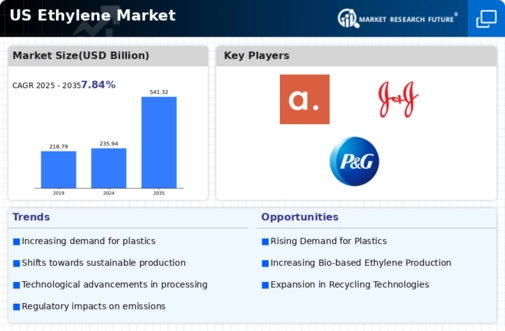The ethylene market exhibits a dynamic competitive landscape characterized by robust growth drivers such as increasing demand for polyethylene and other derivatives, alongside a shift towards sustainable production methods. Major players like Dow Chemical Company (US), ExxonMobil Corporation (US), and LyondellBasell Industries N.V. (US) are strategically positioned to leverage their extensive operational capabilities and technological advancements. Dow Chemical Company (US) focuses on innovation and sustainability, aiming to reduce its carbon footprint while enhancing production efficiency. In contrast, ExxonMobil Corporation (US) emphasizes its integrated business model, which allows for optimized supply chain management and cost efficiencies. LyondellBasell Industries N.V. (US) is actively pursuing digital transformation initiatives to streamline operations and improve product offerings, thereby shaping a competitive environment that prioritizes technological advancement and sustainability.
Key business tactics within the ethylene market include localizing manufacturing and optimizing supply chains to enhance responsiveness to market demands. The market structure appears moderately fragmented, with a few dominant players exerting considerable influence. This collective presence of key players fosters a competitive atmosphere where innovation and operational efficiency are paramount, as companies strive to differentiate themselves in a crowded marketplace.
In November 2025, Dow Chemical Company (US) announced a significant investment in a new ethylene production facility in Texas, aimed at increasing its output capacity by 15%. This strategic move is likely to bolster its market position by meeting the rising demand for ethylene derivatives, particularly in the packaging and automotive sectors. The investment underscores Dow's commitment to enhancing its operational capabilities while aligning with sustainability goals through advanced production technologies.
In October 2025, ExxonMobil Corporation (US) revealed plans to expand its ethylene production at its Baytown facility, with an expected increase of 20% in output. This expansion is indicative of ExxonMobil's strategy to capitalize on the growing demand for ethylene in various applications, including consumer goods and construction materials. The decision reflects a broader trend within the industry to scale up production capabilities in response to market dynamics.
In September 2025, LyondellBasell Industries N.V. (US) launched a new digital platform aimed at enhancing supply chain transparency and efficiency. This initiative is expected to streamline operations and improve customer engagement, positioning LyondellBasell as a leader in digital transformation within the ethylene market. The platform's implementation may serve as a competitive differentiator, enabling the company to respond more effectively to customer needs and market fluctuations.
As of December 2025, current competitive trends in the ethylene market are increasingly defined by digitalization, sustainability, and the integration of artificial intelligence (AI) into production processes. Strategic alliances among key players are shaping the landscape, fostering collaboration on innovative solutions and sustainable practices. Looking ahead, competitive differentiation is likely to evolve from traditional price-based competition to a focus on innovation, technology, and supply chain reliability, as companies seek to establish themselves as leaders in a rapidly changing market.














Leave a Comment